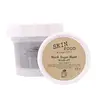What's inside
What's inside
 Key Ingredients
Key Ingredients

 Benefits
Benefits

 Concerns
Concerns

 Ingredients Side-by-side
Ingredients Side-by-side

Sucrose
HumectantPEG-7 Glyceryl Cocoate
EmulsifyingGlycerin
HumectantEuphorbia Cerifera Wax
Macadamia Ternifolia Seed Oil
EmollientCaprylic/Capric Triglyceride
MaskingCetyl Ethylhexanoate
EmollientLanolin
EmollientStearalkonium Hectorite
Gel FormingButyrospermum Parkii Butter
Skin ConditioningLimnanthes Alba Seed Oil
Skin ConditioningCaramel
Cosmetic ColorantSorbitan Laurate
EmulsifyingTocopheryl Acetate
AntioxidantEthylhexylglycerin
Skin ConditioningWater
Skin ConditioningParfum
MaskingSucrose, PEG-7 Glyceryl Cocoate, Glycerin, Euphorbia Cerifera Wax, Macadamia Ternifolia Seed Oil, Caprylic/Capric Triglyceride, Cetyl Ethylhexanoate, Lanolin, Stearalkonium Hectorite, Butyrospermum Parkii Butter, Limnanthes Alba Seed Oil, Caramel, Sorbitan Laurate, Tocopheryl Acetate, Ethylhexylglycerin, Water, Parfum
Water
Skin ConditioningPalmitic Acid
EmollientStearic Acid
CleansingKaolin
AbrasiveStearyl Alcohol
EmollientGlyceryl Stearate Se
EmulsifyingDecyl Glucoside
CleansingParfum
MaskingCoco-Glucoside
CleansingBambusa Arundinacea Stem Extract
Skin ConditioningNiacinamide
SmoothingCetyl Alcohol
EmollientHydrated Silica
AbrasiveCitrus Aurantium Bergamia Peel Oil
Glycine Soja Oil
EmollientTocopherol
AntioxidantGlycerin
HumectantArachidic Acid
CleansingLauric Acid
CleansingMyristic Acid
CleansingArachidyl Alcohol
EmollientMyristyl Alcohol
EmollientXanthan Gum
EmulsifyingCitric Acid
BufferingLevulinic Acid
PerfumingSodium Levulinate
Skin ConditioningP-Anisic Acid
MaskingSodium Gluconate
Skin ConditioningWater, Palmitic Acid, Stearic Acid, Kaolin, Stearyl Alcohol, Glyceryl Stearate Se, Decyl Glucoside, Parfum, Coco-Glucoside, Bambusa Arundinacea Stem Extract, Niacinamide, Cetyl Alcohol, Hydrated Silica, Citrus Aurantium Bergamia Peel Oil, Glycine Soja Oil, Tocopherol, Glycerin, Arachidic Acid, Lauric Acid, Myristic Acid, Arachidyl Alcohol, Myristyl Alcohol, Xanthan Gum, Citric Acid, Levulinic Acid, Sodium Levulinate, P-Anisic Acid, Sodium Gluconate
 Reviews
Reviews

Ingredients Explained
These ingredients are found in both products.
Ingredients higher up in an ingredient list are typically present in a larger amount.
Glycerin is already naturally found in your skin. It helps moisturize and protect your skin.
A study from 2016 found glycerin to be more effective as a humectant than AHAs and hyaluronic acid.
As a humectant, it helps the skin stay hydrated by pulling moisture to your skin. The low molecular weight of glycerin allows it to pull moisture into the deeper layers of your skin.
Hydrated skin improves your skin barrier; Your skin barrier helps protect against irritants and bacteria.
Glycerin has also been found to have antimicrobial and antiviral properties. Due to these properties, glycerin is often used in wound and burn treatments.
In cosmetics, glycerin is usually derived from plants such as soybean or palm. However, it can also be sourced from animals, such as tallow or animal fat.
This ingredient is organic, colorless, odorless, and non-toxic.
Glycerin is the name for this ingredient in American English. British English uses Glycerol/Glycerine.
Learn more about GlycerinParfum is a catch-all term for an ingredient or more that is used to give a scent to products.
Also called "fragrance", this ingredient can be a blend of hundreds of chemicals or plant oils. This means every product with "fragrance" or "parfum" in the ingredients list is a different mixture.
For instance, Habanolide is a proprietary trade name for a specific aroma chemical. When used as a fragrance ingredient in cosmetics, most aroma chemicals fall under the broad labeling category of “FRAGRANCE” or “PARFUM” according to EU and US regulations.
The term 'parfum' or 'fragrance' is not regulated in many countries. In many cases, it is up to the brand to define this term.
For instance, many brands choose to label themselves as "fragrance-free" because they are not using synthetic fragrances. However, their products may still contain ingredients such as essential oils that are considered a fragrance by INCI standards.
One example is Calendula flower extract. Calendula is an essential oil that still imparts a scent or 'fragrance'.
Depending on the blend, the ingredients in the mixture can cause allergies and sensitivities on the skin. Some ingredients that are known EU allergens include linalool and citronellol.
Parfum can also be used to mask or cover an unpleasant scent.
The bottom line is: not all fragrances/parfum/ingredients are created equally. If you are worried about fragrances, we recommend taking a closer look at an ingredient. And of course, we always recommend speaking with a professional.
Learn more about ParfumWater. It's the most common cosmetic ingredient of all. You'll usually see it at the top of ingredient lists, meaning that it makes up the largest part of the product.
So why is it so popular? Water most often acts as a solvent - this means that it helps dissolve other ingredients into the formulation.
You'll also recognize water as that liquid we all need to stay alive. If you see this, drink a glass of water. Stay hydrated!
Learn more about Water